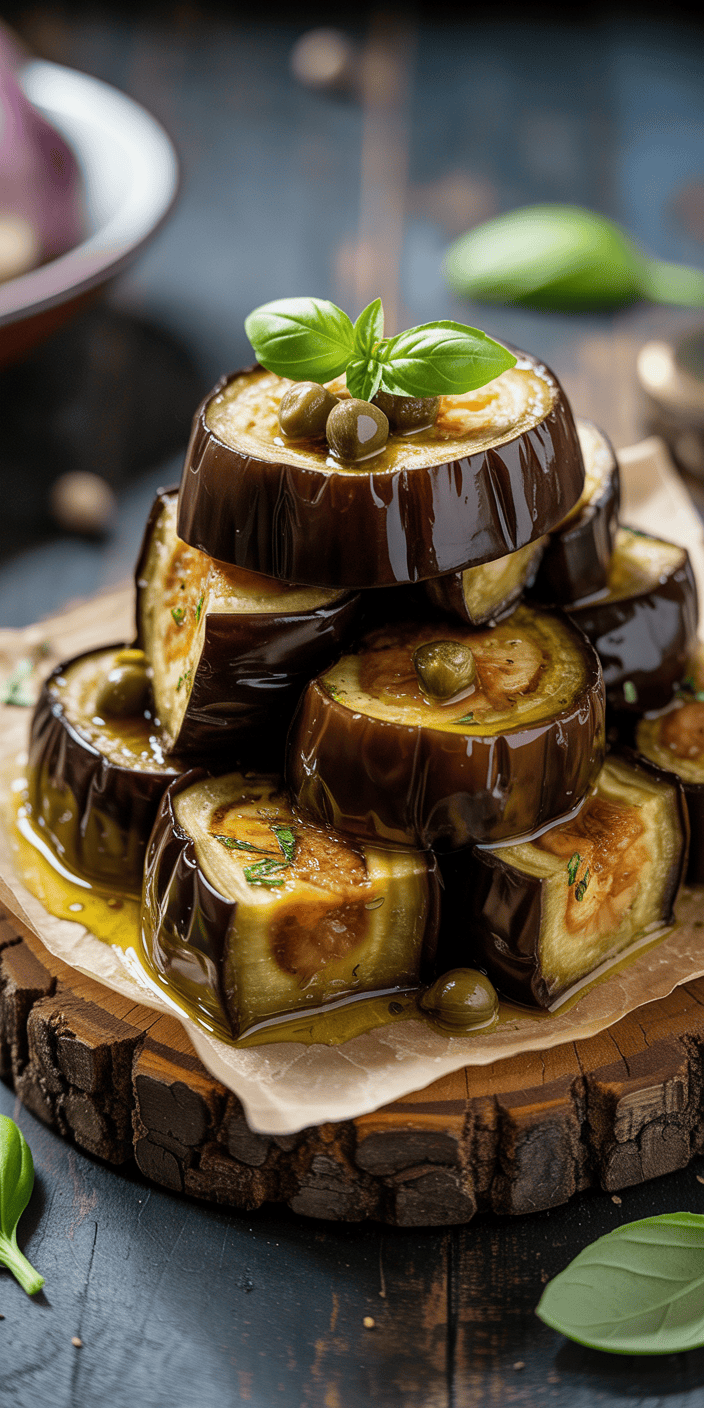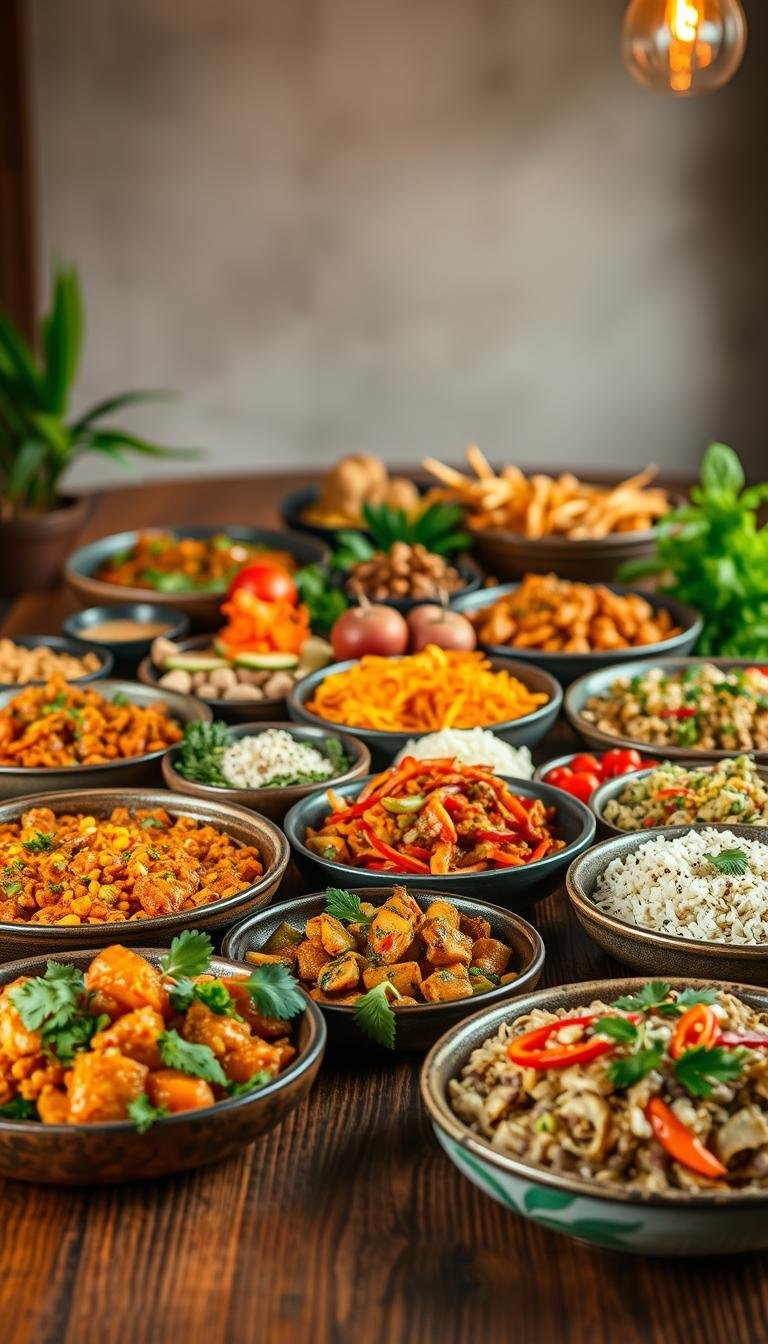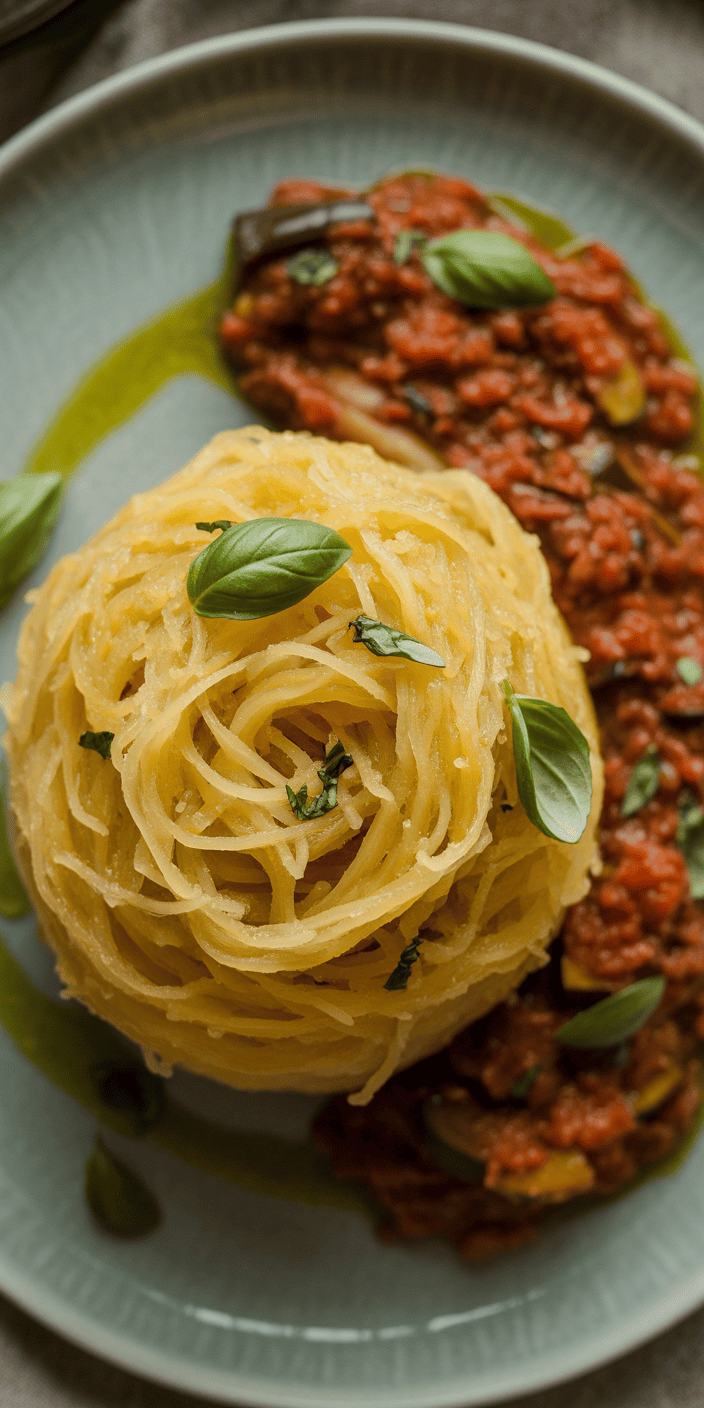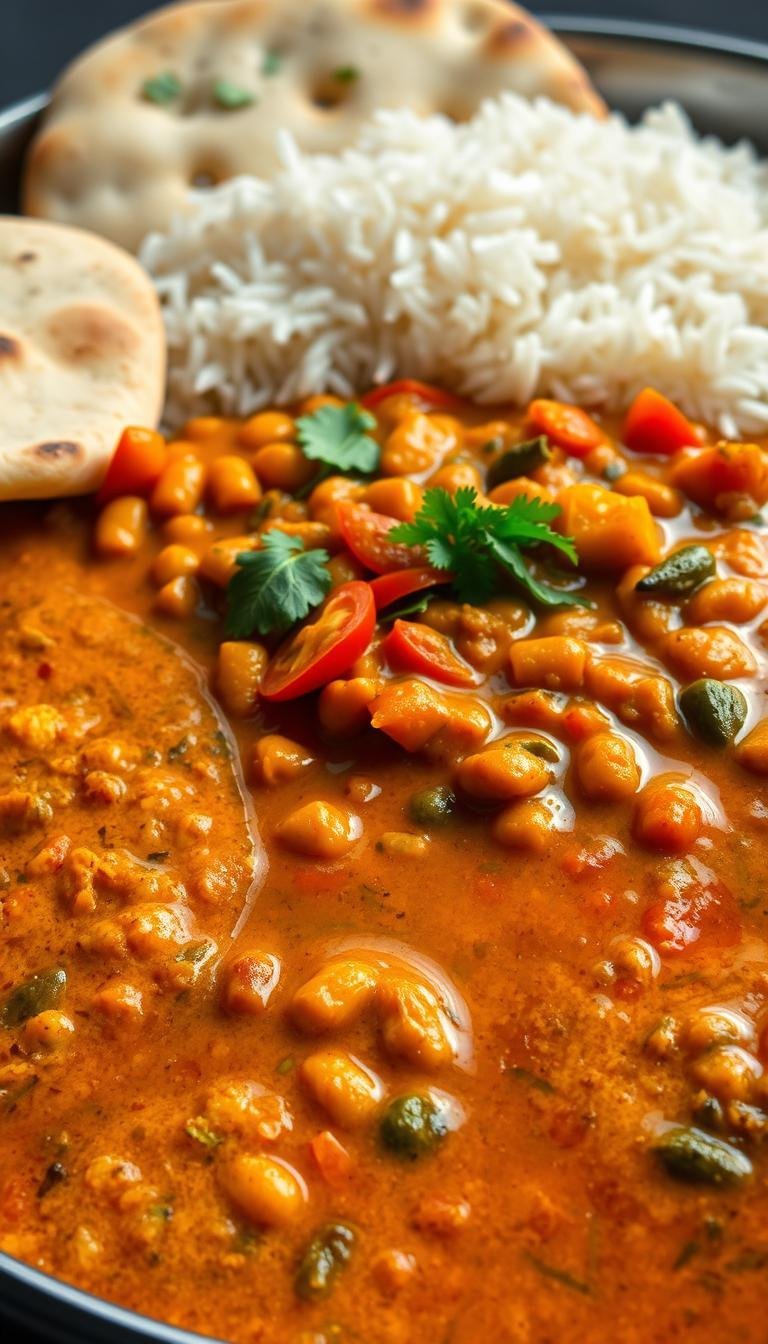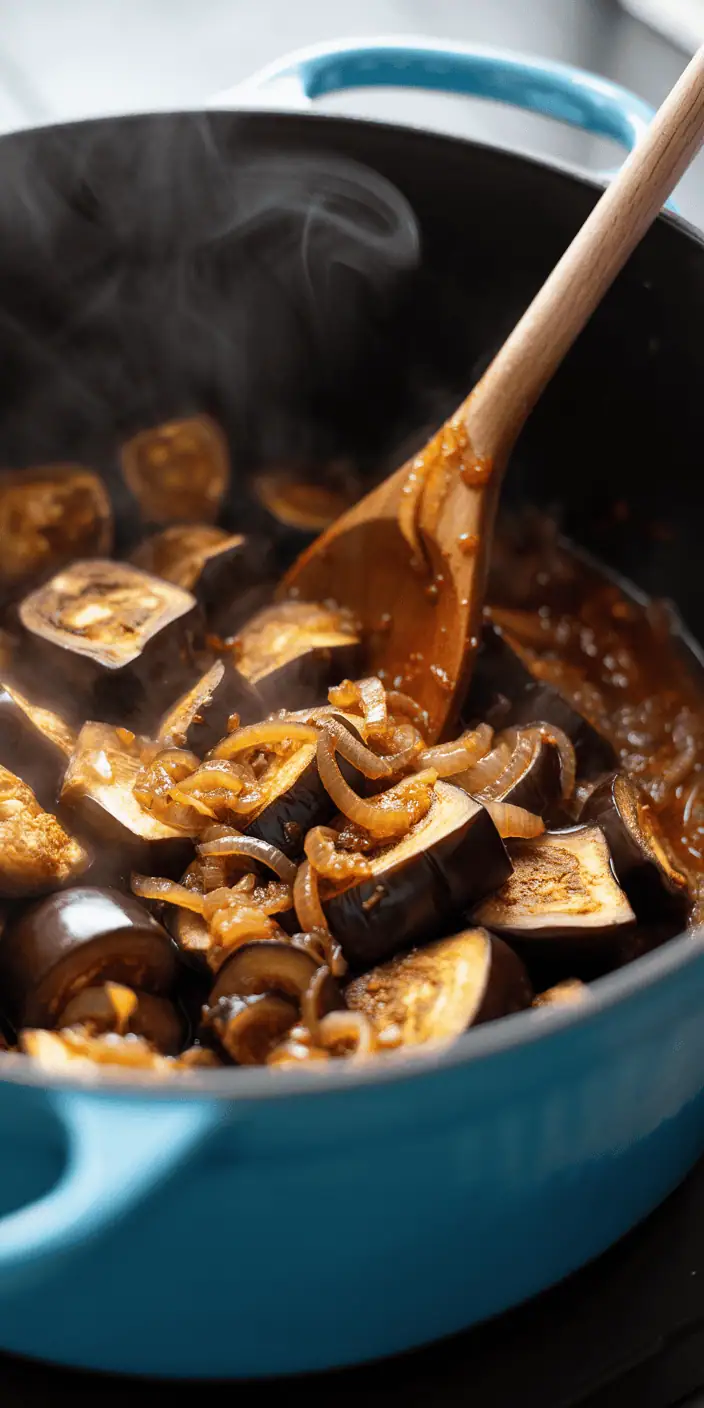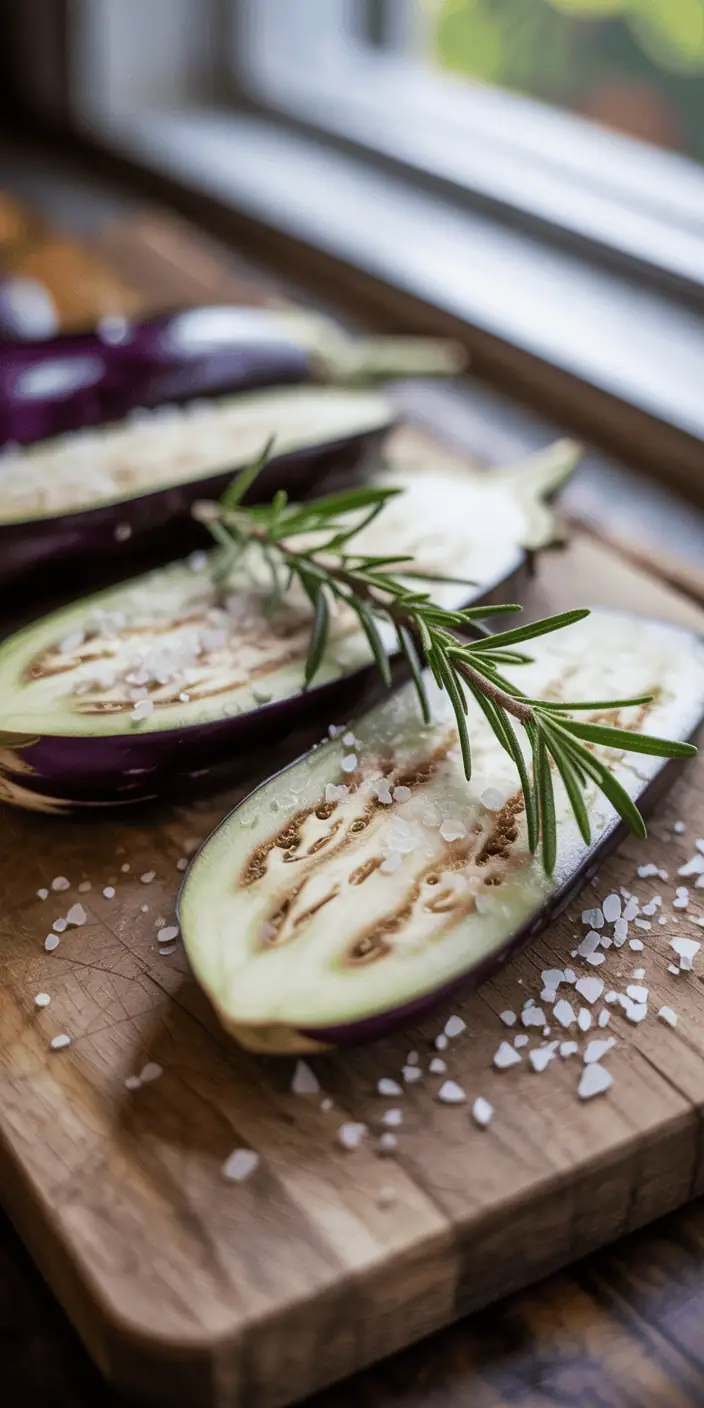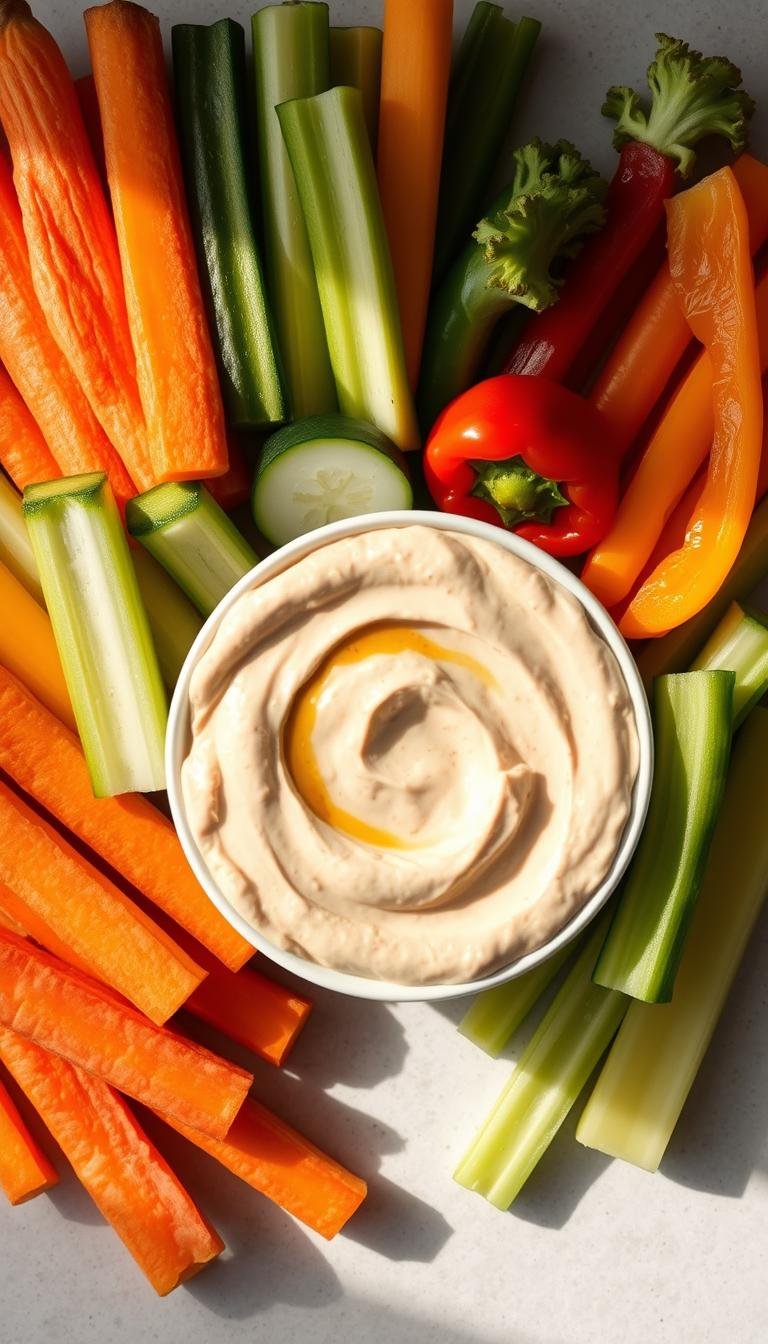(Hey! Some links in this post may be affiliate links — meaning I may earn a small commission if you buy through them, at no extra cost to you. As an Amazon Associate, I earn from qualifying purchases. I only share products I genuinely love and think you’ll find useful too. Read the full disclosure here).
Welcome to one of my absolute favorite Mediterranean appetizers! I’m so excited to share this authentic eggplant caponata recipe with you. It’s a true taste of Sicily that’ll transform your entertaining game forever!
This gorgeous dish combines tender, silky vegetables with a medley of vibrant flavors in a sweet-and-sour sauce that’s simply irresistible. When served on crispy, golden crostini, it creates the perfect bite that’ll have your guests asking for the recipe every single time!
I love how this Sicilian caponata brings together the rustic charm of Italian countryside cooking with elegant presentation. Whether you’re hosting a dinner party, planning a casual get-together, or just want to treat yourself to something special, this appetizer delivers incredible flavors that celebrate the best of Mediterranean cuisine.
Trust me, once you master this recipe, it’ll become your go-to dish that never fails to impress!
Contents
- 1 What is Sicilian Eggplant Caponata
- 2 Essential Ingredients for Authentic Eggplant Caponata
- 3 Kitchen Equipment and Tools Needed
- 4 Preparing the Eggplant
- 5 Creating the Caponata Base
- 6 Step-by-Step Eggplant Caponata Recipe
- 7 Preparing Perfect Crostini
- 8 Assembly and Presentation Tips
- 9 Storage and Make-Ahead Instructions
- 10 Recipe Variations and Adaptations
- 11 Troubleshooting Common Issues
- 12 Conclusion
Key Takeaways
- Authentic Sicilian recipe featuring sweet-and-sour flavors that define traditional Mediterranean cuisine
- Perfect appetizer for entertaining guests at dinner parties or casual gatherings
- Combines tender vegetables with crispy crostini for an irresistible texture contrast
- Easy-to-master recipe that consistently impresses guests and family members
- Versatile dish suitable for both elegant presentations and rustic Italian-style serving
- Celebrates the best flavors of Sicily with vibrant, fresh ingredients
What is Sicilian Eggplant Caponata
Let me introduce you to the crown jewel of Sicilian cuisine – a Mediterranean dish that transforms humble vegetables into pure culinary magic! This incredible Italian appetizer represents so much more than just another eggplant recipe. It’s a beautiful celebration of Sicily’s rich cultural heritage that has been passed down through generations of passionate home cooks.
Origins and Traditional Significance
Caponata has its roots deep in Sicilian history, dating back centuries when resourceful cooks needed to preserve their abundant summer harvest. The dish originally served as a clever way to extend the life of fresh vegetables using traditional preservation techniques. Sweet and sour flavors became the signature of this Mediterranean dish, reflecting the diverse cultural influences that shaped Sicily’s cuisine.
Arab, Spanish, and French culinary traditions all left their mark on this beloved recipe. The combination of vinegar and sugar creates that distinctive agrodolce (sweet-sour) taste that makes caponata so special. Traditional Sicilian families would prepare large batches during peak vegetable season, storing them in cool cellars to enjoy throughout the year.
This Italian appetizer holds deep cultural significance in Sicily, often appearing at family gatherings and religious celebrations. It represents the island’s philosophy of transforming simple, everyday ingredients into something extraordinary through patience and love.
Key Flavor Profile and Characteristics
The magic of caponata lies in its complex flavor symphony that hits every taste bud perfectly! You’ll experience the rich, creamy texture of perfectly cooked eggplant as the star ingredient. The sweetness from tomatoes and added sugar balances beautifully with the tangy bite of vinegar and the briny pop of capers.
Each spoonful delivers layers of flavor that unfold on your tongue. The celery adds a delightful crunch, while onions provide aromatic depth. Pine nuts and raisins – when included in traditional recipes – contribute textural contrast and subtle sweetness that makes every bite interesting.
What I absolutely love about this dish is its chunky yet tender texture that’s neither too smooth nor too rough. The vegetables maintain their individual character while melding together harmoniously. The result is a Mediterranean masterpiece that tastes even better the next day as all those incredible flavors continue to develop and deepen!
Essential Ingredients for Authentic Eggplant Caponata
Quality ingredients transform a simple eggplant recipe into something truly extraordinary for your crostini recipe! I’m absolutely passionate about using the best ingredients because they make such a dramatic difference in the final result. When you’re working with just a handful of components, each one needs to shine and contribute its own special flavor to create that perfect harmony we’re after.
Primary Vegetables and Their Selection
Let’s start with our star ingredient – the eggplant! You’ll want to choose firm, glossy eggplants that feel heavy for their size. Look for that beautiful deep purple color without any soft spots or wrinkles.
The supporting vegetables are just as crucial. Ripe but firm tomatoes work best – I absolutely love using San Marzano tomatoes when I can find them! Their sweet, rich flavor is incredible.
Don’t forget the crisp celery stalks and sweet onions. These add wonderful texture and depth. The celery should snap cleanly when you bend it, and your onions should feel firm with no sprouting.
Aromatics and Seasonings
The aromatics are where the magic really happens! Fresh garlic is absolutely essential – none of that pre-minced stuff from a jar. You want those beautiful, pungent cloves that release their incredible aroma when you crush them.
Quality olive oil is your best friend here. I recommend using extra virgin olive oil with a robust flavor that can stand up to all these bold ingredients.
Those gorgeous briny capers add such incredible bursts of flavor – they’re like little flavor bombs! Fresh basil leaves bring that perfect aromatic finish that makes everything come together beautifully.
For the signature sweet-and-sour element, you’ll need good red wine vinegar and a touch of sugar. This balance is what makes caponata so distinctive and irresistible!
Quality Considerations for Best Results
Here’s my golden rule: invest in the best ingredients you can afford! When you’re working with such simple components, every single one really shines through in the final dish.
Shop for vegetables that are in season – they’ll have more flavor and better texture. Your eggplants should feel substantial and have taut, shiny skin.
Trust me, your taste buds will absolutely thank you for choosing quality ingredients! It’s honestly the difference between good caponata and absolutely incredible caponata that will have your guests asking for the recipe.
Kitchen Equipment and Tools Needed
Having the proper kitchen equipment makes creating this delicious Italian antipasto so much easier and more enjoyable! The wonderful news is that you don’t need any expensive or specialized gadgets to master this classic dish. Most home cooks already have everything needed in their kitchen!
Success with caponata comes down to having reliable basics that make prep work smooth and cooking effortless. I’ve learned that the right tools can transform your Italian cooking experience from stressful to absolutely delightful!
Cookware Requirements
Your most important piece of equipment is a large, heavy-bottomed skillet or sauté pan. I absolutely love using my cast iron or stainless steel pan because they distribute heat evenly and prevent sticking. The pan should be at least 12 inches wide to give all those beautiful vegetables plenty of room!
You’ll also want a large pot for blanching vegetables and a sturdy colander for draining. A medium saucepan comes in handy for reducing vinegar or preparing any additional components. These basic pieces will set you up for antipasto success!
If you’re making homemade crostini, grab a large baking sheet. I prefer rimmed sheets because they prevent anything from sliding off during toasting.
Prep Tools and Utensils
A sharp chef’s knife is absolutely essential for this recipe! It makes chopping eggplant, celery, and onions so much safer and more efficient. Pair it with a large, stable cutting board that gives you plenty of workspace.
You’ll need several mixing bowls in different sizes for organizing ingredients. I like having everything prepped and ready before I start cooking – it makes the whole process flow beautifully! A wooden spoon is perfect for stirring because it won’t scratch your cookware.
Don’t forget measuring cups and spoons for perfect flavor balance. A slotted spoon helps transfer ingredients without excess oil. For crostini preparation, a serrated bread knife creates clean, even slices.
| Essential Equipment | Recommended Size/Type | Primary Use | Alternative Options |
|---|---|---|---|
| Heavy-bottomed skillet | 12-inch cast iron or stainless steel | Sautéing vegetables and building flavors | Large non-stick pan or Dutch oven |
| Chef’s knife | 8-10 inch sharp blade | Chopping all vegetables uniformly | Santoku knife or quality paring knife |
| Cutting board | Large wooden or plastic board | Safe prep surface for ingredients | Multiple smaller boards for organization |
| Mixing bowls | Set of 3-4 various sizes | Organizing prepped ingredients | Large plates or shallow dishes |
Remember, Italian cooking is all about simplicity and letting quality ingredients shine! You don’t need every gadget in the store – just reliable basics that help you work confidently and efficiently in your kitchen.
Preparing the Eggplant
Let me share the game-changing techniques that transform ordinary eggplant into caponata magic! Proper eggplant preparation is absolutely crucial for creating appetizer ideas that will wow your guests. This step makes all the difference between soggy, bitter eggplant and the silky, flavorful foundation your caponata deserves.
I’m going to walk you through every single detail because getting this right sets you up for success. Trust me, once you master these techniques, your party appetizers will never be the same!
Selecting and Cutting Techniques
Choose eggplants that feel heavy for their size and have smooth, glossy skin. The stem should look fresh and green – that’s your sign of a recently picked eggplant!
For cutting, I recommend ¾-inch cubes because they’re the perfect size. They hold their shape beautifully during cooking while still getting tender all the way through. Start by trimming off the stem end, then slice the eggplant lengthwise into ¾-inch thick planks.
Stack your planks and cut them into strips, then turn and dice into cubes. Keep your cuts uniform so everything cooks evenly – this attention to detail really shows in the final dish!
Salting and Draining Process
Here’s the secret step that many home cooks skip: salting your eggplant. This process draws out any bitterness and creates the most amazing texture.
Toss your diced eggplant with about 1 tablespoon of salt per medium eggplant. Place the salted cubes in a colander and let them sit for exactly 30 minutes. You’ll see moisture beading up on the surface – that’s the magic happening!
After 30 minutes, pat the eggplant completely dry with paper towels. This step is crucial because wet eggplant won’t brown properly. Take your time here – really get them dry!
Frying vs. Roasting Methods
You have two fantastic cooking methods, and both deliver incredible results. Choose the one that fits your style and dietary preferences!
Frying gives you that traditional rich flavor and gorgeous golden color. Heat plenty of good olive oil in a large skillet over medium-high heat. Work in batches so you don’t overcrowd the pan – this ensures beautiful caramelization.
Roasting is a lighter option that still delivers amazing taste. Toss your dried eggplant cubes with olive oil and spread them on a baking sheet. Roast at 425°F for 20-25 minutes until tender and golden.
| Method | Temperature | Time | Oil Amount | Best For |
|---|---|---|---|---|
| Frying | Medium-high heat | 8-10 minutes | ½ cup olive oil | Traditional rich flavor |
| Roasting | 425°F | 20-25 minutes | 3 tablespoons olive oil | Lighter, healthier option |
| Pan-searing | Medium-high heat | 12-15 minutes | ¼ cup olive oil | Crispy exterior, tender inside |
Either method you choose, you’ll have perfectly prepared eggplant that’s ready to become the star of your caponata. The key is getting that beautiful golden color and tender texture that makes every bite absolutely delicious!
Creating the Caponata Base
Here’s where the real excitement begins as we build those incredible layers of flavor that make this vegetarian appetizer so irresistible! This magical process transforms simple vegetables into a rich, complex base that will have your guests asking for the recipe. The secret lies in patience and proper technique as each ingredient adds its own special character to our caponata.
Creating the perfect caponata base requires understanding how each element contributes to the final dish. We’re building a foundation that will make this make-ahead appetizer absolutely extraordinary!
Sautéing the Aromatics
Start by heating olive oil in your large skillet over medium heat. Add the diced onions first – they need time to become beautifully translucent and sweet. This usually takes about 5-7 minutes of gentle cooking.
Once your onions are perfectly golden, add the minced garlic. Be careful not to rush this step! Garlic burns quickly, so stir it constantly for just 30-60 seconds until it becomes fragrant and lightly golden.
The celery goes in next, bringing wonderful texture and freshness to our base. Cook for another 3-4 minutes, stirring occasionally. You want the celery to soften slightly while maintaining some of its natural crunch.
Building Layers of Flavor
Now comes the truly magical part where everything starts coming together! Add your diced tomatoes to the aromatic mixture. They’ll begin to break down and create a gorgeous sauce that binds everything beautifully.
Season generously with salt and freshly ground black pepper. Add the tomato paste and stir well – this intensifies the tomato flavor and adds richness to our base.
Here’s where we create that distinctive sweet-and-sour profile that makes Sicilian caponata so unique. Add the red wine vinegar and a pinch of sugar, stirring to combine. The kitchen will smell absolutely incredible at this point!
| Ingredient | Cooking Time | Key Purpose | Texture Goal |
|---|---|---|---|
| Onions | 5-7 minutes | Sweet foundation | Translucent, soft |
| Garlic | 30-60 seconds | Aromatic depth | Fragrant, golden |
| Celery | 3-4 minutes | Fresh crunch | Slightly tender |
| Tomatoes | 8-10 minutes | Sauce base | Broken down, saucy |
Achieving the Perfect Texture
The key to perfect caponata texture is finding that sweet spot where everything melds together without becoming mushy. Each vegetable should maintain its own character while harmonizing beautifully with the others.
Reduce the heat to medium-low and let the mixture simmer gently. This allows the flavors to develop and concentrate while the vegetables reach their ideal texture. Patience is absolutely essential here!
Stir occasionally to prevent sticking, and taste as you go. The base should be rich, slightly sweet, and perfectly balanced. This foundation will make your caponata absolutely unforgettable!
The secret to great caponata lies not in rushing the process, but in allowing each layer of flavor to develop fully and naturally.
Step-by-Step Eggplant Caponata Recipe
Now comes the most exciting part – bringing all your beautifully prepared ingredients together into one incredible dish! This is where your kitchen transforms into a little corner of Sicily, and you get to create one of the most beloved Italian vegetables dishes that’s perfect for any gathering.
I’m going to walk you through each step so you can make perfect caponata every single time. The key is patience and gentle handling – we want to preserve all those beautiful textures and flavors you’ve worked so hard to develop!
Combining All Ingredients
Here’s where the magic truly happens! Start by gently folding your perfectly prepared eggplant into the aromatic base you created earlier. Be incredibly gentle – those gorgeous eggplant pieces should stay intact and beautiful.
Add your ingredients in this specific order for the best results:
- Capers first – they’ll release their briny goodness throughout the dish
- Fresh herbs next – basil and oregano work beautifully here
- Pine nuts and raisins – for that authentic sweet-and-savory balance
- Vinegar and sugar – the classic agrodolce that makes caponata so special
Fold everything together with a wooden spoon, moving slowly and deliberately. You want every piece coated with those incredible flavors without breaking anything apart!
Cooking Time and Temperature Control
This is absolutely crucial for authentic caponata! Reduce your heat to the lowest setting possible. Low and slow is the secret to developing those complex, harmonious flavors that make this one of the greatest entertaining recipes ever created.
Let everything simmer gently for 15-20 minutes. You’ll know it’s working when:
- The mixture becomes glossy and beautiful
- All the flavors start to meld together
- Your kitchen smells absolutely incredible
Stir occasionally, but don’t overdo it. We want gentle integration, not aggressive mixing that breaks up our lovely vegetables!
Final Seasoning Adjustments
This is where you become the artist! Taste your caponata and adjust the flavors to your personal preference. The beauty of this dish is its adaptability!
Here’s what to look for and adjust:
- Too bland? Add a pinch more salt
- Needs more tang? Splash in extra vinegar
- Want more sweetness? Stir in a touch more sugar
- Missing brightness? Fresh lemon juice works wonders
When it’s perfect, your caponata should be rich, complex, and absolutely irresistible. The flavors should dance together in perfect harmony – sweet, sour, salty, and savory all balanced beautifully.
Congratulations! You’ve just created authentic Sicilian magic in your own kitchen. This incredible dish will be the star of any gathering and will have everyone asking for your secret!
Preparing Perfect Crostini
Nothing beats the satisfying crunch of homemade crostini as the perfect base for our delicious eggplant caponata! The crostini isn’t just a simple bread slice – it’s the foundation that elevates your entire appetizer experience. When you master this technique, you’ll create the ideal contrast between crispy bread and tender, flavorful caponata.
I love how the right crostini brings everything together beautifully. The key is finding that perfect balance between sturdy support and delicate crunch that makes each bite absolutely divine!
Bread Selection and Slicing
Your bread selection makes all the difference in creating amazing crostini! I always reach for high-quality Italian breads like ciabatta or rustic sourdough. These breads have the perfect texture and flavor that complements our caponata beautifully.
The ideal slice thickness is about half an inch. This gives you enough structure to hold the topping without breaking. At the same time, it’s thin enough to achieve that gorgeous crispy texture throughout.
When slicing, use a sharp serrated knife for clean cuts. Avoid pressing down too hard – let the knife do the work! This prevents crushing the bread and keeps those lovely air pockets intact.
Toasting Techniques for Optimal Crunch
My favorite toasting techniques involve using the oven for the most even results. Preheat your oven to 400°F – this temperature gives you that perfect golden color we’re after!
Brush each slice lightly with good olive oil before toasting. This creates the most beautiful crispy exterior while keeping the inside tender. Arrange the slices on a baking sheet in a single layer.
Toast for about 8-10 minutes until they’re golden and crispy. Keep an eye on them – ovens can vary! The perfect crostini should be crispy on the outside but still have a slight give when you bite into it.
Flavoring Options
Here’s where you can get creative and add your personal touch! A light rub of fresh garlic on the warm crostini adds incredible flavor. Just cut a garlic clove in half and gently rub it across the surface.
Try sprinkling a pinch of sea salt before toasting for extra flavor depth. Fresh herbs like rosemary or thyme also work wonderfully – just sprinkle them on before the bread goes into the oven.
For a Mediterranean twist, brush with herb-infused olive oil instead of plain olive oil. The combination of crispy bread and aromatic herbs creates the most satisfying contrast with our tender caponata!
Assembly and Presentation Tips
Now comes the exciting part – transforming your delicious components into a stunning appetizer that will absolutely wow your guests! This is where your hard work really shines and you get to be creative with your presentation. The beauty of eggplant caponata on crostini lies in how the colors, textures, and flavors come together to create something truly spectacular.
Proper Serving Temperature
Here’s a wonderful secret about caponata – it tastes absolutely best at room temperature! This means you can prepare everything ahead of time without worrying about keeping things warm. Room temperature allows all those incredible Mediterranean flavors to really shine through and blend together beautifully.
Let your caponata sit out for about 30 minutes before serving if it’s been refrigerated. This brings out the full depth of the sweet and sour flavors. Your crostini should be served at room temperature too, maintaining that perfect crispy texture that contrasts so nicely with the tender caponata.
Garnishing and Visual Appeal
The natural colors of caponata are absolutely gorgeous – those deep purples from the eggplant, rich reds from tomatoes, and bright greens from fresh herbs create edible art on your serving platter! These presentation tips will make your appetizer look restaurant-quality.
Top each crostini with a generous spoonful of caponata, then add a fresh basil leaf for that pop of green color. A light drizzle of good olive oil adds shine and richness. For extra elegance, sprinkle some toasted pine nuts or a few capers on top.
Arrange your crostini on a rustic wooden board or elegant white platter – both work beautifully! Leave some space between each piece so guests can easily pick them up. These serving suggestions help create an inviting display that shows you’ve put love into every detail.
Portion Control Guidelines
Getting the portions just right ensures every guest gets to enjoy this delicious appetizer! Use about 2-3 tablespoons of caponata per crostini – enough to create an abundant-looking mound that’s easy to eat in a few bites.
Plan for 3-4 pieces per person as an appetizer, or 6-8 pieces if you’re serving this as a light lunch. Don’t forget to provide small cocktail napkins and maybe some small spoons for any caponata that might fall off!
| Occasion | Pieces Per Person | Caponata Amount | Crostini Needed |
|---|---|---|---|
| Cocktail Party | 3-4 pieces | 1/2 cup per person | 1 baguette per 8 people |
| Dinner Appetizer | 2-3 pieces | 1/3 cup per person | 1 baguette per 12 people |
| Light Lunch | 6-8 pieces | 1 cup per person | 1 baguette per 4 people |
| Large Gathering | 4-5 pieces | 2/3 cup per person | 1 baguette per 6 people |
Remember, it’s always better to have a little extra than to run out! Your guests will definitely want seconds of this incredible appetizer.
Storage and Make-Ahead Instructions
One of the best parts about making eggplant caponata is how wonderfully it stores and improves with time! This incredible dish is perfect for busy hosts who love to plan ahead. The flavors actually deepen and become more complex after sitting for a day or two.
I absolutely love dishes that make entertaining easier. Caponata is a fantastic example of make-ahead instructions that actually improve your final result!
Refrigeration Best Practices
Your beautiful caponata will stay fresh in the refrigerator for up to one week when stored properly. Here’s how to get the best results:
- Use airtight containers – Glass containers work wonderfully
- Cool completely before refrigerating to prevent condensation
- Leave some headspace in your container for easy stirring
- Bring to room temperature before serving for optimal flavor
The magic happens during those first 24-48 hours! All those gorgeous Mediterranean flavors have time to meld together beautifully.
Freezing Considerations
Caponata freezes beautifully for up to three months! This makes it perfect for food storage and meal planning. Follow these simple steps:
- Cool completely before freezing
- Use freezer-safe containers with tight-fitting lids
- Leave expansion space – about one inch at the top
- Label with date for easy tracking
When you’re ready to enjoy your frozen caponata, thaw it overnight in the refrigerator. Give it a gentle stir and taste for seasoning adjustments.
The texture stays remarkably good after freezing! You might notice slight changes in the eggplant, but the overall flavor remains incredible.
Reheating Methods
Reheating caponata is simple and flexible. You have several great options depending on your preference:
Room temperature serving (my favorite!) – Simply let it sit out for 30-45 minutes. This brings out all the flavors perfectly.
Gentle stovetop warming – Heat over low heat, stirring occasionally. Add a splash of olive oil if needed.
Microwave option – Heat in 30-second intervals, stirring between each round.
For the crostini, store them separately in an airtight container for up to two days. If they lose their crispness, just pop them in a 350°F oven for 3-5 minutes. Fresh crostini always taste best!
These make-ahead instructions make caponata perfect for entertaining. You can focus on enjoying your guests instead of worrying about last-minute cooking!
Recipe Variations and Adaptations
What makes caponata truly special is its incredible versatility, allowing you to create your own unique spin on this beloved Italian dish! I’m absolutely thrilled to share all the recipe variations and creative ways you can make this classic your own.
The beauty of caponata lies in how it welcomes experimentation while staying true to its Mediterranean roots. Whether you’re accommodating special diets or exploring regional traditions, there’s a perfect version waiting for you!
Regional Italian Variations
Throughout Italy, different regions have put their own delicious stamp on traditional caponata! In some northern areas, cooks add pine nuts and golden raisins for a sweet-savory combination that’s absolutely divine.
Sicilian variations might include green olives for extra briny flavor, while some coastal regions incorporate roasted bell peppers for added sweetness and gorgeous color. I’ve also seen versions with fresh mint leaves that add a bright, herbaceous note!
Some recipe variations include capers from Pantelleria or sun-dried tomatoes for deeper Mediterranean flavors. Each region’s twist reflects local ingredients and family traditions passed down through generations.
Dietary Modifications
The wonderful news is that caponata is naturally accommodating for various dietary adaptations! It’s already vegetarian and vegan-friendly, making it perfect for plant-based entertaining.
For gluten-free guests, simply serve your caponata with gluten-free bread or enjoy it as a standalone side dish. The flavors are so rich and satisfying that it doesn’t need anything else!
If you’re watching sodium intake, reduce the salt during cooking and let the natural vegetable flavors shine. You can also experiment with low-sodium vegetable broth instead of additional salt for depth.
Creative Serving Suggestions
Beyond traditional crostini, there are so many exciting ways to enjoy caponata! I love using it as a pasta sauce – it’s incredible tossed with rigatoni or penne for a hearty weeknight meal.
Try it as a topping for grilled chicken or fish, or use it as a filling for savory tarts and galettes. It makes an amazing addition to cheese boards, paired beautifully with fresh mozzarella or aged Parmesan.
For casual entertaining, serve it warm as a side dish with grilled meats, or stuff it into pita pockets for a Mediterranean-inspired lunch. You can even use it as a pizza topping or mix it into grain bowls for added flavor and nutrition!
Troubleshooting Common Issues
Cooking troubleshooting becomes much easier when you know what to look for and how to fix it! Even experienced home cooks sometimes run into little hiccups with their caponata. I want to make sure you feel confident handling any situation that might come up.
Don’t worry if things don’t go perfectly the first time. Most recipe problems have simple solutions that’ll get you back on track!
Texture Problems and Solutions
Texture issues are the most common challenge when making caponata. If your eggplant turns out too mushy, it might be because it was overcooked or the pieces were cut too small.
Here’s how to fix texture problems:
- Too mushy: Try larger chunks and shorter cooking time next batch
- Too firm: Give it a few more minutes of gentle cooking
- Too wet: Cook uncovered for extra minutes to reduce liquid
- Too dry: Add a splash of good olive oil or little water
Remember that caponata should have a chunky, rustic texture – not smooth like a puree!
Flavor Balance Adjustments
Flavor balance is so important in caponata! The sweet and sour elements need to work together perfectly.
Use these quick fixes for flavor issues:
- Too acidic: Add a pinch more sugar
- Too sweet: Add a splash more vinegar
- Lacks depth: Try a pinch of salt or fresh herbs
- Bland overall: Taste and adjust seasonings gradually
Trust your palate and don’t be afraid to make small tweaks until it tastes perfect to you!
Storage and Freshness Concerns
Proper storage prevents most freshness problems. If your caponata develops an off smell or strange appearance, it’s time to make a fresh batch.
Watch for these storage warning signs:
- Sour or unpleasant odors
- Mold growth on surface
- Slimy texture when stirred
- Color changes after several days
Stored properly in the refrigerator, your caponata should stay fresh and delicious for up to five days. Cooking troubleshooting becomes second nature with practice – you’ve got this!
Conclusion
You’ve now discovered the secrets behind creating an authentic Italian appetizer recipe that brings the heart of Sicily right to your kitchen! This eggplant caponata on crostini represents so much more than just another dish – it’s your gateway into the wonderful world of Mediterranean cooking.
The beauty of mastering this recipe lies in its versatility. Whether you’re planning an intimate dinner party or a casual weekend gathering, this caponata becomes your reliable showstopper. Your guests will be amazed by the rich, complex flavors you’ve created from such simple ingredients.
Remember, every time you prepare this dish, you’re connecting with generations of Italian home cooks who perfected these techniques. The sweet and sour balance, the tender eggplant, and the aromatic herbs all come together to create something truly special on those crispy crostini.
Don’t hesitate to make this recipe your own! Experiment with the variations we’ve explored, and let your creativity shine. The most rewarding part of Mediterranean cooking is sharing these delicious moments with family and friends around your table.
Now grab your apron, gather your ingredients, and start creating memories one delicious bite at a time!
🍆 Love eggplant? Explore more dishes in our roundup: 15 Delicious Eggplant Recipes You Need to Try

